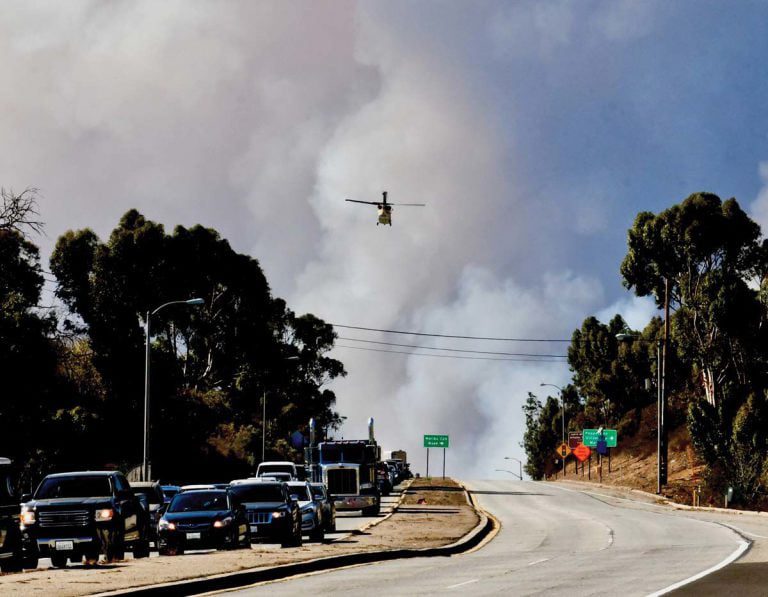
In the months following the Woolsey Fire in November 2018, many residents thought the city should have had a citywide siren warning system making sure that everyone got the message to evacuate. The fire destroyed most communication systems as it swiftly burned across the mountains, and many found themselves without power, cell reception, TV, internet or even radio. As a result, many never received official warnings about the fire.
In response, the city contracted Mission Critical Partners to conduct a siren sound study to determine what Malibu would need in order to build an effective outdoor siren warning system, primarily for wildfires. The study included whether a siren system could be heard indoors, the sound-diminishing effects of Santa Ana winds and operating during power outages, including Edison’s controversial PSPS—public safety power shutoff—program.
The consultants presented their results to the Malibu Public Safety Commission during a Zoom meeting last week, recommending a mix of high and low powered sirens on 22 specific sites with poles throughout the city. Lower-powered speakers located at Point Dume, Zuma Beach and the Civic Center area would enable the city to make voice announcements. High-powered speakers issuing tones only would make up the rest, with sound reaching the city limits.
MCP estimated the system would cost $1.2 to $1.9 million, not including site acquisitions or environmental impact studies.
John Mazza, a planning commissioner who made public comments, was concerned that each of the 22 poles would cost about $30,000 and need its own environmental impact report—”a huge, huge administrative cost.”
Following the presentation, public safety commissioners expressed doubts about whether people inside their homes or experiencing strong Santa Ana winds could really hear the sirens.
The commissioners voted, 4-1, to receive and file the siren report, but requested to see more options on fire warning systems presented at the next meeting—maybe more high-tech and/or radio-based.
Community Wildfire Protection Plan public survey results
A lot of communities have a Community Wildfire Protection Plan; Malibu does not. When Public Safety Manager Susan Dueñas saw an opportunity last year to get grant money for Malibu to have its own plan, she seized it.
“A plan already exists for the Santa Monica Mountains,” she said in an interview with The Malibu Times, “but it’s big and broad. It’s useful to the Fire Department, but we wanted to know what we could do at the neighborhood level.”
The city and consultant Jenson Hughes hosted two stakeholder meetings at City Hall in February to solicit input for the plan. That was followed by an online public survey conducted from Feb. 20 to June 20, asking Malibu residents about fire preparedness, and how the Woolsey Fire could have been handled better. Only 225 households participated.
“The responses show a lot of fear and misunderstanding [about the fire and how it was handled],” Commission Chair Chris Frost said. “I expected a thousand replies, but the 225 responses represented between 700 and a thousand [household members].”
Commissioner Doug Stewart agreed with Frost that it was tough reading the responses to some questions.
“The last 40 pages are gut-wrenching,” he said. “People wrote entire essays on those last questions.”
Those questions asked things like, “During the Woolsey Fire, did you feel like you received enough information from city/county agencies regarding the status of the fire and what measures/steps you needed to take to remain safe?”
One response: “None received, had to rely on those who swam into Malibu to learn more. No cell service, no utilities, no proper responses to requests. Immediately after [the] fire we had flooding with no city support whatsoever, even though canyon was decimated. Homes destroyed. Couldn’t drive in. No support, no help. Responses from city, ‘Can’t help a private road with anything.’ Outrageous and shameful.”
The commission voted, 5-0, to work on a comprehensive safety plan based on the survey results. The raw data, including the open-ended responses which have not yet been organized or analyzed, can be viewed on the online agenda for this meeting.
Latest on the Trancas bridge replacement and right-hand turn lane
Public Works Director Rob DuBoux confirmed that Caltrans will replace the 96-year-old bridge at PCH and Trancas Creek because of failing foundations, cracks and rusted reinforcements. The new bridge will be larger to accommodate storm flows from Trancas Creek. It will have two travel lanes, a bike lane and a shoulder on each side. During construction, four lanes are expected to remain open, but bike and pedestrian pathways will shift around. A temporary traffic signal will be installed at Guernsey Avenue.
Caltrans has estimated the project cost at $12.5 million and construction will begin in February 2021. The project is scheduled to be heard by the planning commission in September.
The city will finally construct a new westbound dedicated right-turn lane on PCH at Trancas Canyon Road, with the approval of Caltrans, to accommodate right turns onto Trancas Canyon Road and into the Trancas Country Market. The project will be funded with Measure R Highway Operational Improvement funds.
That right-hand turn lane has been a point of contention for 10 years. In 2010, the city and owner of Trancas Country Market, Zuma Properties, agreed to terms that would result in that right-hand turn lane being constructed. It never happened, and the city, Caltrans and the property owner all pointed fingers at each other.